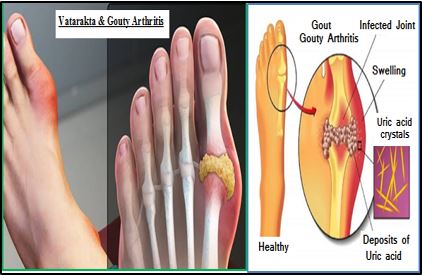Vatarakta : An Ayurvedic classical literature review
DOI:
https://doi.org/10.21760/jaims.8.6.34Keywords:
Ayurveda, Vatarakta, Uttana, Gambhira, Gouty arthritis.Abstract
The statement “The inequalities of basic constituents in the body are the root cause for different diseases” is the fundamental principle of the Ayurveda, which indicate the control of different fundamental elements in the body (Sharira) is the sign of good health and free from diseases. Ayurvedic remedies and therapies are found very effective and useful to sustain the equilibrium of these fundamental elements in the body. Vatarakta is a chronic joint and body pain disease accompanied by pain, stiffness, swelling over joints which involve vitiated Vatadosha as well as Raktadhatu. Aggravated Vata is blocked by vitiated Rakta, which leads to further aggravation of Vata Dosha. Vatarakta have two Avasthas i.e., Uttana and Gambhira. Uttana Vatrakta affects Twacha and Mansadhatu whereas Gambhira mainly affects Asthi, Majjadi Gambhira Dhatu. Nidan Panchak is one of the finest and important method of diagnosing disease, its causes & prognosis. Nidan Panchak consists of 5 components viz. Nidan, Purvarupa, Rupa, Upshaya & Samprapti. Every component of Nidan Panchak helps the physician for better understanding of disease growth & treating the disease at an earliest possible stage. Nidana Panchak is the main and important diagnostic tools in Ayurveda. The present life style not only disturb the healthy Aahar but Vihara also. Sedentary lifestyle along with mental stress, consumption of nonveg and highly protein diet, excessive alcohol intake are some of the causing factors which origins acute exacerbation of Vatarakta. The etiological factors responsible for Gouty arthritis, pathology and clinical features are quite similar to Vatarakta.
Downloads
References
Vaidya Yadavaji Trikamji, Charaka Samhita of Chakrapani dutta (1992) edited by Publishers Munshi Ram Manoharlal Pvt. Ltd. New Delhi.
Sharma Shiv. Ashtanga Hridaya Deepika hindi tika (1996) by Publishers Khem Raj, Krishan das Prakashan Bombay.
Kashinath Shastri and Gorakhnath Chaturvedi, Charaka Samhita, Ch.Chi,29/11 Choukhamba bharti Academy, Varanasi,2001, 2:820.
Kavi Ambikadutta shastri, Sushruta Samhita, Choukhamba Sanskrit Sansthan 2007
Kashinath Shastri, Charaka Samhita, Choukhamba Sanskrit Sansthan 2009,730
Agnivesha, Charaka Samhita (Revised by Charak and Dridhabala) with Vidyotini Hindi Commentary edited by Kashinathshastri and Dr. Goraknath Chaturvedi, Reprint ed. Nidanasthana: Chapter 1, Verse 44. Varanasi: Chaukhamba Bharti Academy 2009, Sutrasthana, p. 15.
Agnivesha, Charaka Samhita. Chaukhambha Sanskrit Sansthan Varanasi: 2002. p.984 (Ch. Chi. 29/11)
Harita Samhita. Hindi Commentary by Ramavatar shastri, prachya prakashan, Varanasi, 1st Edition, 1985.
Anjana Nidana, Agnivesha. In: Ramchandra Shastri Kinjavadekara, editor, Chitrashala Mudranalaya, Pune. 1940.
Agnivesha, Charaka Samhita. Varanasi: Chaukhambha Sanskrit Sansthan; 2002. p.984 (ch,chi 29/5-10)
Kavi Ambikadutta Shastri, Sushruta Samhita , Choukhamba Sanskrit Sansthan 2018.p.299-300 (su.ni.1/40-42)
Vaidya Shukla S V, Kayachikitsa, part 2, Rakthavaha vyadhi’s 7/5. edition 1st Varanasi. Chaukhamba orientalia, 2012; 676.
Savitri et al. “Innovative Ayurvedic Vivechana Of Vata-Rakta - A Conceptual Study” wjpmr, 2020,6(4),p50-53.
Agnivesha Charaka Samhita English translation and critical exposition by Dr. Ram Karan Sharma & Vaidya Bagavan Dash vol 5, Chikitsa Sthana 29th chapter, page 1146, 26th edition, Chaukhambha Sanskrit Series, 2000.
Yadunandana Upadhyaya, Madhavakara S, Madhavanidanam. chapter 25, 10st sloka. Chaukhamba Sanskrit Sansthan; 1985. p. 462.
Agnivesha, Charakasamhitha Sutrasthana chapter 26. sloka 86–87. 4th edn. Varanasi: Chaukhambha Sanskrit Sansthan; 1994. p.362.
Shrikhantamurty KR. Ashtangasangraha Suthrasthana chapter 9/9 Varanasi: Chaukhambha Orientalia; 1996. p. 201.
Shrikhantamurty KR. Ashtangasangraha Sutrasthana chapter 9/7. Varanasi: Chaukhambha Orientalia; 1996. p. 200.
Yadunandana Upadhyaya, Madhavakara S, Madhavanidanam. chapter 25, 10st sloka. Chaukhamba Sanskrit Sansthan; 1985. p. 462.
Tripathi B. (2011) Charaka Samhita; Varanasi: Chaukhambha Prakashan; Vol.-II; Chikitsa Sthana ch.29. p.983. sh.no.8-11.
Tripathi B. (2011) Ashtanga Hridaya; (Reprint) Varanasi: Chaukhambha Orientalia; Vol.1; Nidana Sthana, ch.16.p.545. sh.no.3.
Agnivesha, Charaka samhitha. Varanasi: Chaukhambha Sanskrit Sansthan; 2002. p.988 (Cha. Chi. 29/31-32)
Vaidya Yadavji Trikamji, Sushruta Samhita, Chikitsa sthanam Mahavatavyadhichikitsa 5/14-15. 2nd Varanasi. Chaukhamba surbharti prakashana, 2012.
Kavi Ambikadutta shastri, Sushruta Samhita , Choukhamba Sanskrit Sansthan 2018.p.40 (Su. Chi. 5/10)
Agnivesha, Charakasamhitha. Varanasi: Chaukhambha Sanskrit Sansthan; 2002. p.995 (Cha. Chi. 29/74)
Agnivesha, Charaka samhita with Ayurveda deepika teeka, Chaukhamba Sanskrit samsthan, Varanasi, 2000; 29.
Art of health chiro.com
Harsh Mohan, Text book of pathology, Jaypee Brothers medical Publishers, New Delhi 2019















